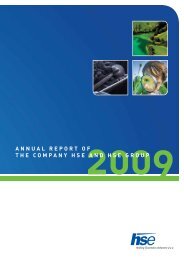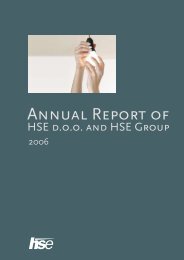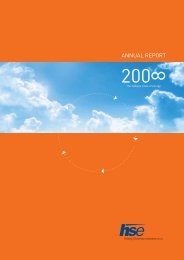Annual report - HSE
Annual report - HSE
Annual report - HSE
Create successful ePaper yourself
Turn your PDF publications into a flip-book with our unique Google optimized e-Paper software.
in €<br />
Changes in allowances for short-term receivables 2012 2011<br />
Balance as at 1 January 29,965 458,922<br />
Written-off receivables collected 0 -189,035<br />
Allowances for receivables 824,308 19,336<br />
Final write-down of receivables 0 -259,258<br />
Balance as at 31 December 854,273 29,965<br />
Receivables by maturity date Not yet due Up to From 3 to From 6 to Over one year TOTAL<br />
3 months 6 months 12 months<br />
Short-term operating receivables 142,868,760 7,417,155 0 29,965 0 150,315,880<br />
Short-term financial receivables 109,317,324 0 0 0 0 109,317,324<br />
Long-term operating receivables 870,313 0 0 0 0 870,313<br />
Balance as at 31/12/2011 253,056,397 7,417,155 0 29,965 0 260,503,517<br />
Short-term operating receivables 206,076,457 9,190,366 0 1,109,647 29,965 216,406,435<br />
Short-term financial receivables 303,576,705 0 0 0 0 303,576,705<br />
Long-term operating receivables 676,352 0 0 0 0 676,352<br />
Balance as at 31/12/2012 510,329,514 9,190,366 0 1,109,647 29,965 520,659,492<br />
in €<br />
Receivables with maturity of up to three months were settled before the end of January<br />
2013.<br />
As at 31 December 2012, the company had EUR 3,189,580 of overdue trade liabilities which<br />
were repaid by 4 January 2013. A portion of its liabilities to suppliers are secured with bank<br />
guarantees, bills of exchange and other forms of insurance.<br />
4.5.8.8.2 Liquidity risk<br />
Liquidity or solvency risk is the risk associated with insufficient financial sources and the<br />
subsequent inability of the company to settle its liabilities in due time. In accordance with<br />
Financial Operations, Insolvency Proceedings and Compulsory Dissolution Act (ZFPPIPP),<br />
the company <strong>HSE</strong> manages its liquidity risks by preparing and exercising the policy of<br />
regular liquidity management, which is confirmed by the SB in the <strong>Annual</strong> Business Plan.<br />
For this purpose, the company’s liquidity is monitored on daily, monthly and annual basis.<br />
The Supervisory Board and management are informed about it regularly.<br />
The company monitors and actively manages the liquidity risks with:<br />
<strong>Annual</strong> Report <strong>HSE</strong> 2012<br />
4 Financial Report of the company <strong>HSE</strong><br />
152<br />
• regular monitoring of cash flows on daily, monthly and annual level,<br />
• cash management on the Group level; the main goal of cash management is optimisation<br />
of liquidity of the Group companies through exploitation of synergy effects of the Group<br />
as a whole,<br />
• assuring liquidity reserve in form of credit lines approved at commercial banks (in form<br />
of revolving loans and limits on bank accounts),<br />
• allocation of short-term liquidity surpluses in form of safe and liquid short-term deposits<br />
at commercial banks and in form of cash pooling on the Group level,<br />
• active relationship towards financial markets.<br />
During financial crisis, the management of solvency risks is of utmost importance, which is<br />
why we additionally intensified our carefulness in managing solvency risk. The company<br />
devotes special attention to efficient cash flow planning, which enables timely prediction<br />
of possible liquidity surpluses and deficits and their optimal management.
















